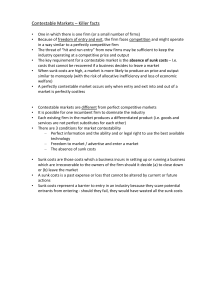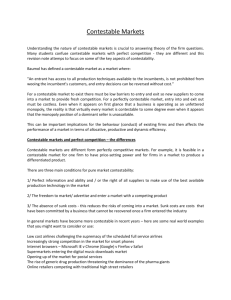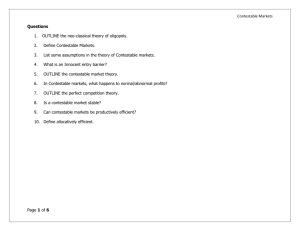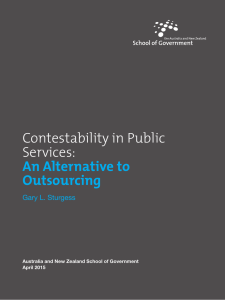contestable markets
advertisement
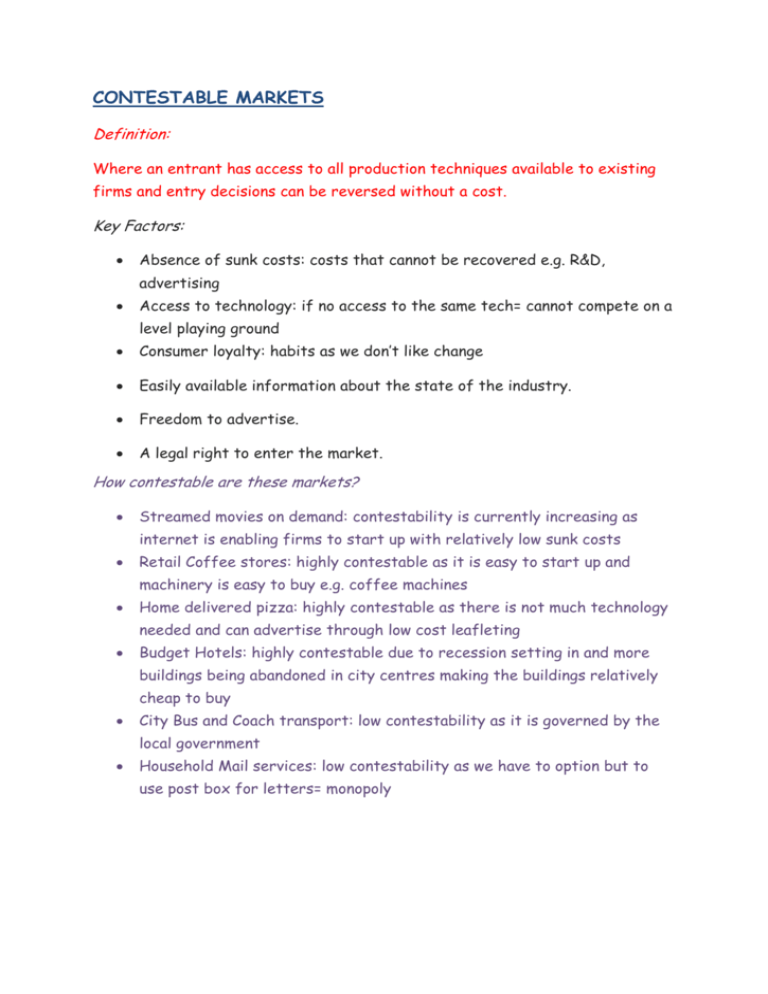
CONTESTABLE MARKETS Definition: Where an entrant has access to all production techniques available to existing firms and entry decisions can be reversed without a cost. Key Factors: Absence of sunk costs: costs that cannot be recovered e.g. R&D, advertising Access to technology: if no access to the same tech= cannot compete on a level playing ground Consumer loyalty: habits as we don’t like change Easily available information about the state of the industry. Freedom to advertise. A legal right to enter the market. How contestable are these markets? Streamed movies on demand: contestability is currently increasing as internet is enabling firms to start up with relatively low sunk costs Retail Coffee stores: highly contestable as it is easy to start up and machinery is easy to buy e.g. coffee machines Home delivered pizza: highly contestable as there is not much technology needed and can advertise through low cost leafleting Budget Hotels: highly contestable due to recession setting in and more buildings being abandoned in city centres making the buildings relatively cheap to buy City Bus and Coach transport: low contestability as it is governed by the local government Household Mail services: low contestability as we have to option but to use post box for letters= monopoly Barriers to entry brand loyalty Control of important technologies Expertise & reputation of existing firms Limit pricing: to prevent new rivals Predatory pricing: drive out existing firms Ownership of market licences Patent/trademark protection Government awarded franchises Barriers to exit Asset write-offs Lost consumer goodwill Redundancy costs Hit and run entry Easy entry into a market without incurring sunk costs and expecting immediate profit Strong brands make it easier If an industry is making supernormal profits, then a firm can enter and take advantage of the high prices and high profits. If prices fall and the industry is no longer profitable, then the firm will leave. Therefore in a contestable market a firm should be satisfied with normal profits otherwise it would encourage hit and run tactics. Contestable Markets and the Public Interest Contestable markets can bring the benefits of competitive markets such as: Lower prices Increased incentives for firms to cut costs. Increased incentives for firms to respond to consumer preferences. The firm will be closer to allocative and productive efficiency than in a monopoly. Could also be significant economies of scale because the theory of contestable markets doesn’t require there to be thousands of firms. Therefore policy makers should not just look at the degree of concentration, but also the degree of contestability and how easy it is to enter the market. Regulators in the privatised industries have often focused on removing barriers to entry, rather than breaking up big firms To examine the contestability of an industry, we should look at: 1. Level of Sunk Costs- needs to be low. If sunk costs are high this makes it difficult for new firms to enter and leave the market. Therefore it will be less contestable. 2. Levels of Advertising and brand loyalty- need to be low. If an established firm has significant brand loyalty such as Coca Cola, then it will be difficult for a new firm to enter the market. This is because they would have to spend a lot of money on advertising which is a sunk cost. 3. The level of Profit- needs to be low for hit and run entry to reduce profitability If a firm is making very high profit, this is an indication that the market is not contestable, because hit and run competition should enable new firms to enter and reduce the profitability of the industry. 4. Vertical Integration- helps firm have all the tech needed to compete If a firm does not have access to the supply of a good then the market will be less contestable. E.g. the big oil firms could restrict the supply of petrol tonew petrol stations, making it difficult for new firms to enter. For airlines, a big issue is whether you can get a landing slot at a big airport. 5. Access to technology and skilled labour – must be easily accessed For some industries like car production it is difficult for new firms to have the right technology. Nuclear power may require skilled labour that is difficult to get. Degrees of Contestability It is important to remember that contestability is not a clear cut issue, there are degrees of contestability, some markets having more capacity for new firms to enter. Methods to Increase the Contestability of Markets 1. Remove legal barriers to entry The Royal Mail used to be a legal monopoly but now firms are allowed to enter the market for sending letters. This has increased contestability. 2. Force firms to allow competitors to use its network For example when BT was privatised, OFTEL forced BT to allow other companies to use its network. This has also occurred in the Gas and Electricity industries and has made them more contestable. 3. Legislation against Predatory Pricing If a firm can engage in predatory pricing it can force new firms out of business and make it less contestable. 4. OFT can legislate against theabuse of Monopoly power If a firm abuses its monopoly power by restricting supply to certain firms the OFT can intervene to overcome this restriction on contestability.


